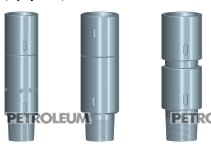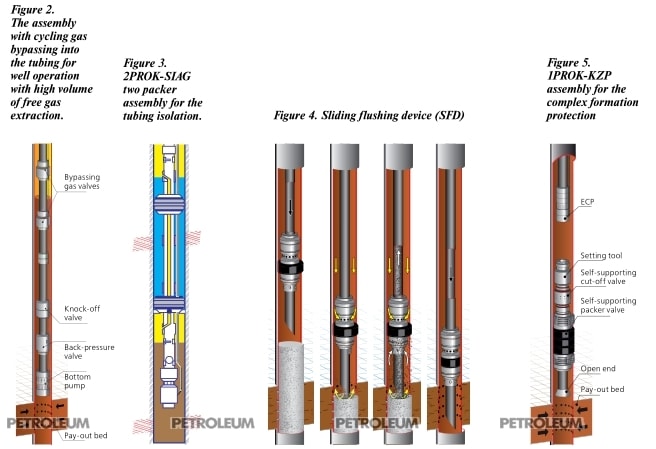GLOBAL ATYRAU OIL&GAS
Abnormal Well Stock RPC Paker Technology
KADETOV Aleksey. Process Engineer of Well Technology Development and Application Service of RPC PAKER LLC.
ZMEU Artyom. Head of Well Process Technology Development and Application Service of RPC PAKER LLC.
Abnormal well stock of most oil companies is a large part of the total number of the operational wells. Experts of RPC PAKER have developed a number of technologies, successfully applied both in Russia and abroad, which allowed to operate and repair the abnormal wells.
 Fig. 1. Emergency disconnection units (safety units)
Fig. 1. Emergency disconnection units (safety units)
Safety removal of downhole pumping equipment
The risk of blocking, due to strewing or dropping the foreign objects should be eliminated when running any submersible equipment within the well.
For this reason, the safety blocks shall be used when running underground equipment (fig. 1). In case of any complications during the lifting motion, there is a possibility of detaching the tubing string from the stuck equipment. Depending on the applied safety block, one of the following methods shall be applied: string tension, jetting, turning the tuning to the right. The removing is carried out using a catcher for the process tubing.
Gas locking
When gas ratio at the pump suction exceeds an allowable value during the well operation, the dynamic level in the well decreases to critical point, resulting in gas locking and ESP failure. Experts of RPC PAKER developed the process technology for well operation with high volume of free gas. The technology is about cyclical free gas bypassing from annular space into the tubing string (fig. 2) via KPE-115/KPG-O bypass valves. One valve is installed at a some distance from ESP, and the second one- at a certain distance from the wellhead. The well operates with a closed annular space.
When the pressure of gas, accumulated in the annular space, reaches a threshold value, the gas is throttled through the KPE-115/KPG-O bypass valve into the tubing string. When the gas pressure in the annulus is aligned with the pressure of fluid inside the tubing string at the level of valve installation, the latter is closed and the gas accumulation process starts again. Then the process is repeated cyclically.
As a result of using this technology, the well shall be brought to a stable production without gas locking, there is a gas lift effect, the temperature increases in the annular space and the asphaltite-resin-paraffin deposits are reduced.
A specific feature of KPG- O valves is that only the gas is bypassed through it. The valve closes if any liquid reaches it. This specific feature allows to use it during the well development with a compressor, as well as the well control in one cycle.
Gas withdrawal from the tail space
When isolating the leaking tubing in a well with high gas factor with use of one packer assembly with cable input, there is a problem of bypassing the excess gas from the tail space. The above-mentioned bypass valves or capillary lines are used to resolve this problem.
One of the technological ways of isolating the tubing string is 2PROK-IVEG two-packer assembly (fig. 3). The assembly uses a direct connection between the space behind the packer and those of tail space. This allows to provide a natural gas separation from the tail space, ensuring an uninterrupted operation of ESP without gas locking, to define the dynamic level in the annular space and to conduct a standard "resuscitation" of a pump, resulting from the well flushing.
Well flushing in case of circulation loss
Traditional methods of direct and back flushing from the mechanical sediments are not perfect. For example, a serious disadvantage of direct flushing is a relatively low-speed of upward fluid flow. The key disadvantage of back flushing is that the speed of downward fluid flow in the annular space is very low, which stipulates the reduction of intensity of plugs blowout and water jet effect.
Taking into account the identified disadvantages, the engineers of RPC Paker developed a well flushing technology with use of a special sliding flushing device (SFD) (Pic. 4). The advantages of this method include a substantial reduction or complete exclusion of a flushing fluid loss, accelerated well commissioning after elimination of sand plug, as well as a possibility of cleaning-up the string part, located below the filter holes. SFD combines the advantages of traditional methods of flushing: cake is washed as in case of a direct flushing, and mechanical impurities are taken out at a higher speed, as during back flushing.
The main positive effect from implementation of flushing via SFD is in reduction of dynamic influence on the formation by reducing the fluid column impact, because the annular space is overlapped by SFD sealing element . The leakage of the fluid decreases in 3-5 times (example of EK-140 and EK-146), and the speed of fluid flow increases. In addition, an underpressure is created: i.e flushing with tubing string under depression. Therefore, the pollution of the reservoir is excluded or substantively reduced, since the mud fluid phase does not penetrate it: on the contrary, the formation fluids arrive to the well.
Clogging protection-fast commissioning (with a cutoff valve)
Well control during a current repair and the workover, especially in conditions of low formation pressure and a high absorption value stipulate the processes of well-killing fluid filtrate penetration and other related colmatation processes, occurrence of local water flooding, pushing of oil phases deep ward the formation and occurrence of resistant water-oil emulsification. Finally, it leads to decreasing a potential well production rate and to increasing the time for its development.
In order to reduce the losses during well repair, two major method of formation protection are used: chemical (use of block-batches) and mechanical ones. The latter options include the complex formation protection technology with use of 1PROK-KZP assembly, developed by RPC PAKER LLC (Fig.5).
This assembly is installed independently above the formation for a longtime.
After the pump start-up while decreasing the dynamical level and reducing the hydrostatic pressure to a certain set value, valve opening and well operation processes are started in the cutoff valve. The pump stop stipulates the rise of dynamic level and hydrostatic overpressure above the cutoff valve, as well as valve closing process for its repair/change. Also, the hydrostatic pressure increased by a liquid volume change before repairing the well.
1PROK-KZP assembly with cutoff valve resist both top-down and down-top pressure drop. The valve is equipped with a forced opening assembly for equalization of pressure in the under-paker and above-paker spaces before the packer stall. Opening and closing pressures are set within the interval from 5,0 to 20,0 MPa.
Operations with the formation protection are carried out in the following order. Firstly, the equipment is run into the tubing and installed at the specified depth. Then the tubing string is detached from the installed assembly using a setting tool and the downhole pumping equipment is run down.
After the formation fluid replacement with the well control fluid, the submersible pump shall be replaced in the behind-packer space. At the fluid displacement, the flushing fluid does not penetrate the tail space. Further, new or restored downhole pumps shall be run into the well and it shall be operated until the next repair period.
In order to remove the assembly, the tubing string is shall be tied along the setting tool and before the packer stall by the ball knock-out and supplying the tubing pressure; the forced assembly is opened and the pressure is equilized at two sides of the packer.
Packer installation at small depths and in the horizontal areas.
While operating the high-viscosity oil wells, steam-injection wells or individual injection wells, the packer and anchor equipment should be installed at depths up to 200-300 m, at the same time, the weight of the tubing string is not enough and it is required to create some additional efforts for packer seating. Special assembly of YAKPRO-SDU (fig. 5) successfully resolves this problem. It can be used for packer or packer assembly installation in case of underweight tubing string, as well as in case of incline or horizontal sites on the well bore.
This reusable assembly is characterized by a simple operation process, and it represents a hydraulic jack according to its construction.
Packer is installed at the required depth, the pressure is supplied to the tubing, a tool come into action and the packer is being fixes in the string with a required load. In order to make 15-16 t load, it will be enough to supply the pressure equal to 15,0-25,0 MPa.




